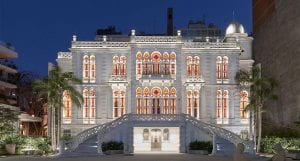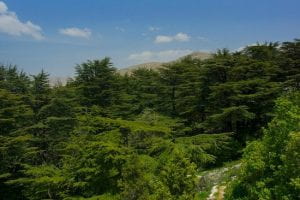Places to see in Lebanon:
Sursock Museum
 The Sursock Museum was built in 1912 as a private residence by Nicolas Sursock, a Lebanese art collector and a prominent member of one of the aristocratic families of Beirut. It is a splendid example of 19th century Levantine architecture. Nicolas Sursock who died in 1952, bequeathed his villa to the city of Beirut. According to his will, the villa was transformed into a museum of modern art which opened its doors in 1961 with an exhibit of works of contemporary Lebanese and international artists. The museum underwent its first renovation in the 1970s. The second renovation completed in 2015, was much more drastic with the addition of four underground floors comprising more exhibition space, library, auditorium, and the archives. The museum’s collection consists of 5,000 pieces, including paintings, sculptures, ceramics, glassware, and iconography, dating back to the 18th, 19th, and 20th centuries.
The Sursock Museum was built in 1912 as a private residence by Nicolas Sursock, a Lebanese art collector and a prominent member of one of the aristocratic families of Beirut. It is a splendid example of 19th century Levantine architecture. Nicolas Sursock who died in 1952, bequeathed his villa to the city of Beirut. According to his will, the villa was transformed into a museum of modern art which opened its doors in 1961 with an exhibit of works of contemporary Lebanese and international artists. The museum underwent its first renovation in the 1970s. The second renovation completed in 2015, was much more drastic with the addition of four underground floors comprising more exhibition space, library, auditorium, and the archives. The museum’s collection consists of 5,000 pieces, including paintings, sculptures, ceramics, glassware, and iconography, dating back to the 18th, 19th, and 20th centuries.
Casino Du Liban
 First opened in 1959, the Casino closed in 1989 and reopened in 1996 after a $50 million reconstruction and refurbishment project. It is located in Maameltein – Jounieh, 22 Km north of Beirut. With an area of about 35,000 square meters, the casino has around 400 slot machines and 60 gaming tables. It has a showroom, night club, theater, banquet facility and five restaurants. With an unrivalled prestige, the Salle des Ambassadeurs is an internationally renowned venue that has shaped the reputation of Casino du Liban due to its legendary pre-war performances which immersed the audience in a marvelous world of fantasy and delight. Lavish and elegant, the incomparable venue is one to admire and remember. With a 600 plus seating capacity, a blend of traditional service and a modern-day sophistication, the Salle des Ambassadeurs is the epitome of a new art of living, featuring a series of remarkable performances that have mesmerized the public with grandeur and extravagance.
First opened in 1959, the Casino closed in 1989 and reopened in 1996 after a $50 million reconstruction and refurbishment project. It is located in Maameltein – Jounieh, 22 Km north of Beirut. With an area of about 35,000 square meters, the casino has around 400 slot machines and 60 gaming tables. It has a showroom, night club, theater, banquet facility and five restaurants. With an unrivalled prestige, the Salle des Ambassadeurs is an internationally renowned venue that has shaped the reputation of Casino du Liban due to its legendary pre-war performances which immersed the audience in a marvelous world of fantasy and delight. Lavish and elegant, the incomparable venue is one to admire and remember. With a 600 plus seating capacity, a blend of traditional service and a modern-day sophistication, the Salle des Ambassadeurs is the epitome of a new art of living, featuring a series of remarkable performances that have mesmerized the public with grandeur and extravagance.
Cedars Forest

The Cedar is the national emblem of Lebanon. North Lebanon’s Cedar Forest near Bsharri, the Cedars of God, represents only small remnants of the original forest. The first attempt at preserving the Cedar forest was made by the Roman Emperor Hadrian. The Mamluk Caliphs during the Middle Ages attempted at conserving the Cedars. In 1832, the Maronite Patriarch placed the majestic trees under his protection. In 1876, Queen Victoria financed a wall to protect the Cedars of God from the ravages of goat herding.
Beirut
 Beirut is the capital and largest city of Lebanon. Located on a peninsula at the midpoint of Lebanon’s Mediterranean coast, it serves as the country’s largest and main sea port. The first mention of this metropolis is found in the ancient Egyptian Tell el Amarna letters, dating from the 15th century BC. The city has been inhabited continuously since then. The city is the focal point of the region’s cultural life, renowned for its press, theatres, cultural activities and night-life. After the destructive Lebanese Civil War, Beirut underwent major reconstruction, and the redesigned historic city center, marina, pubs and night life districts have once again made it a tourist attraction. Beirut was named the top place to visit by The New York Times in 2009 and as one of the ten liveliest cities in the world by Lonely Planet in the same year.
Beirut is the capital and largest city of Lebanon. Located on a peninsula at the midpoint of Lebanon’s Mediterranean coast, it serves as the country’s largest and main sea port. The first mention of this metropolis is found in the ancient Egyptian Tell el Amarna letters, dating from the 15th century BC. The city has been inhabited continuously since then. The city is the focal point of the region’s cultural life, renowned for its press, theatres, cultural activities and night-life. After the destructive Lebanese Civil War, Beirut underwent major reconstruction, and the redesigned historic city center, marina, pubs and night life districts have once again made it a tourist attraction. Beirut was named the top place to visit by The New York Times in 2009 and as one of the ten liveliest cities in the world by Lonely Planet in the same year.

Recent Comments